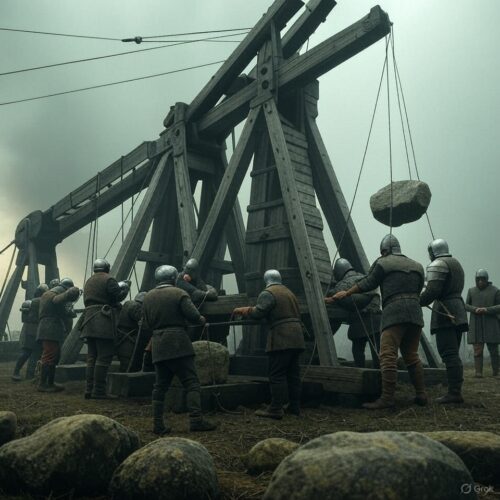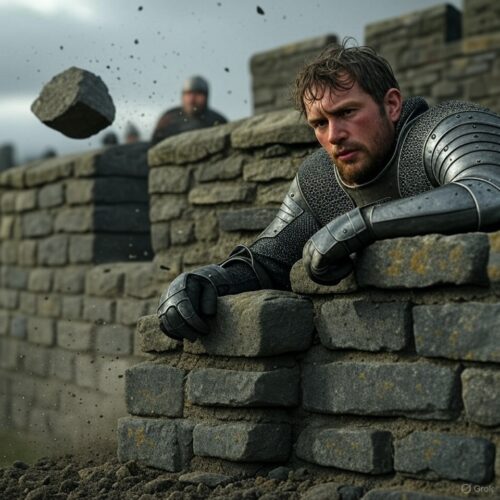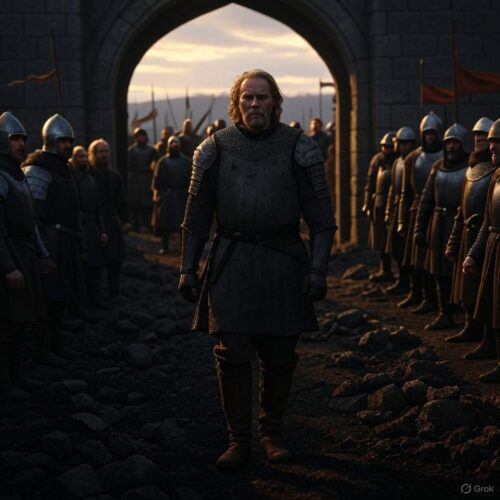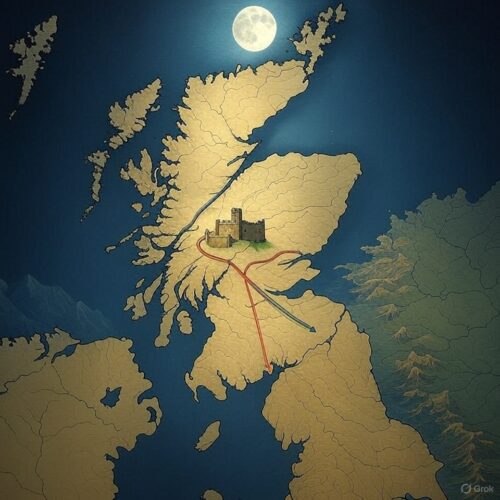On July 20, 1304, a dramatic chapter in Scottish history drew to a close as Stirling Castle, the last bastion of Scottish resistance in the First War of Scottish Independence, surrendered to the relentless forces of King Edward I of England. This wasn’t just the fall of a fortress—it was the end of a grueling three-month siege, a clash of wills, and a showcase of medieval ingenuity that reverberated through the centuries. Picture this: a towering castle perched atop a rugged hill, battered by the mightiest trebuchet of its time, and defended by a handful of Scots who refused to yield until the very end. This event is steeped in historical richness, brimming with details of warfare, strategy, and human tenacity. But beyond the dust of 14th-century battlefields, the fall of Stirling Castle offers lessons that can ignite inspiration in our lives today. In this 3000+ word journey, we’ll dive deep into the historical nitty-gritty, paint vivid scenes of the siege, and uncover how this medieval saga can empower you with practical, life-changing insights. Plus, we’ll unearth a lesser-known historical gem from July 20th to broaden our horizons even further. Ready to storm the ramparts of history? Let’s begin!
—
### The Stage is Set: The First War of Scottish Independence
To grasp the weight of Stirling Castle’s fall, we need to rewind the clock to the late 13th century. Scotland was a land in turmoil. In 1286, King Alexander III met a grim fate when he fell from his horse, leaving no clear heir to the throne. What followed was a chaotic scramble among Scottish nobles, each vying for power in a kingdom suddenly adrift. Enter King Edward I of England, a towering figure with a reputation as fierce as his nickname, “Hammer of the Scots.” Smelling opportunity in Scotland’s disarray, Edward stepped in as an arbiter to choose a new king, but his intentions were far from neutral. In 1292, he installed John Balliol as a puppet ruler, only to invade Scotland four years later when Balliol resisted English control.
The First War of Scottish Independence erupted in 1296. Edward’s forces crushed the Scots at the Battle of Dunbar, deposed Balliol, and seized key strongholds. Yet, the Scottish spirit refused to break. Figures like William Wallace ignited a rebellion, scoring a stunning victory at Stirling Bridge in 1297, only to face defeat at Falkirk a year later. By 1304, after years of guerrilla warfare and shifting fortunes, Edward had tightened his grip on Scotland. Castle after castle fell to his armies—Dumbarton, Edinburgh, Roxburgh—until only Stirling Castle remained, a solitary symbol of defiance.

Why was Stirling Castle so crucial? Its position was everything. Nestled on a volcanic crag above the River Forth, it commanded the main route between Scotland’s Lowlands and Highlands. Control Stirling, and you controlled the nation’s lifeline—a fact not lost on either side.
—
### The Siege Unfolds: A Medieval Standoff
The siege of Stirling Castle kicked off in April 1304, when Edward I rolled up with an army estimated at over 1,000 men, including knights, archers, and engineers. His target: the castle’s small garrison of about 30 Scots, led by Sir William Oliphant, a knight whose name would soon echo through history. These defenders weren’t just holding a fortress—they were holding onto hope itself.
Edward came prepared. His arsenal included an array of siege weapons: catapults, battering rams, and, most famously, the Warwolf—a trebuchet so massive it redefined medieval warfare. Historical accounts suggest it took 30 wagons to transport its parts, which were assembled on-site over weeks. Standing over 300 feet tall, the Warwolf could hurl stones weighing up to 300 pounds, turning castle walls into rubble with terrifying precision.

The Scots weren’t idle. Inside the castle, Oliphant and his men braced for the onslaught. They’d stocked provisions, reinforced walls, and prepared to outlast the English. For three months, the siege raged. The English unleashed a barrage—stones crashed into the castle, fire rained from the sky, and lead balls (likely melted from nearby church roofs) pounded the defenses. One chronicler notes Edward’s glee as he watched the Warwolf in action, even rejecting an early surrender offer just to see his war machine perform.

Life inside Stirling Castle grew grim. Food ran low—some accounts hint at rats and leather becoming sustenance. The walls, once formidable, cracked and crumbled. Yet, the Scots repaired what they could, their resolve unshaken. Oliphant’s leadership shone through; he kept morale alive, rallying his men with the promise of honor, even as defeat loomed.
By mid-July, the end was near. The Warwolf had breached the outer defenses, and the garrison’s numbers dwindled from exhaustion and injury. On July 20, 1304, Oliphant made a fateful decision. After 90 days of defiance, he negotiated surrender terms with Edward. The English king, perhaps impressed by the Scots’ tenacity, spared their lives—a rarity in medieval warfare. The garrison marched out, heads high, forced to pledge allegiance to Edward but alive to tell the tale.

The fall of Stirling Castle marked a turning point. Edward declared victory, believing he’d crushed Scottish resistance for good. But history had other plans. Within two years, Robert the Bruce would reignite the fight, culminating in the triumph at Bannockburn in 1314. Stirling’s fall was a pause, not an end.

—
### Historical Details: The Nuts and Bolts of the Siege
Let’s dig deeper into the siege’s mechanics. Edward’s army wasn’t just a mob—it was a well-oiled machine. His engineers, likely drawn from across his realm, were masters of siegecraft. The Warwolf wasn’t his only weapon; smaller trebuchets, mangonels, and ballistae joined the fray, each designed to target different parts of the castle. Mangonels lobbed stones in high arcs, while ballistae fired bolts with deadly accuracy at defenders on the walls.
The Warwolf itself was a spectacle. Its counterweight system—possibly 10 tons of lead or stone—allowed it to fling projectiles over 200 yards. Chroniclers like the Lanercost Chronicle describe Edward’s delight as he ordered a viewing platform built to watch it smash Stirling’s walls. One tale claims he even sent a stone crashing through a wall just as Oliphant’s emissaries approached to surrender, a flex of power as much as tactics.
Inside, the Scots faced a fortress under strain. Stirling Castle, built over centuries, had thick stone walls—some 12 feet wide—but they weren’t invincible. The Warwolf’s bombardment targeted the gatehouse and curtain walls, exploiting weak points. The garrison likely used crossbows and longbows to harass English engineers, though their ammo was limited. Water came from a well within the castle, but food stores—grain, salted meat, maybe some dried fish—couldn’t last forever.
Edward’s strategy extended beyond brute force. He cut off supply lines, using cavalry to patrol the surrounding countryside and starve the Scots out. Psychological warfare played a role too—the constant thud of stones and roar of fire wore on the defenders’ nerves. Yet, Oliphant’s negotiation at the end showed cunning; by securing safe passage, he preserved his men for future fights.
—
### Echoes in Today’s World: Five Lessons to Live By
The fall of Stirling Castle isn’t just a dusty relic—it’s a goldmine of wisdom for modern life. Here’s how this medieval epic can fire you up and shape your days:
- **Perseverance Pays Off**
The Scots held out for 90 days against impossible odds. That grit is a blueprint for us. Whether you’re chasing a promotion, training for a marathon, or battling a tough semester, sticking it out can turn the tide.
– **Benefit**: Builds resilience, turning setbacks into stepping stones.
- **Strategy Trumps Chaos**
Edward’s meticulous planning and the Scots’ adaptive defense highlight the power of strategy. In your life, a clear plan beats winging it every time—be it a career move or a budget overhaul.
– **Benefit**: Sharpens focus, maximizing your resources and time.
- **Tech is Your Ally**
The Warwolf flipped the script on medieval warfare. Today, tech—think AI tools, apps, or even a fitness tracker—can revolutionize how you work, learn, or live.
– **Benefit**: Boosts efficiency, giving you an edge in a fast-paced world.
- **Lead Like a Legend**
Oliphant’s cool-headed command under fire is leadership gold. Whether you’re managing a team or steering your own path, staying steady in chaos inspires trust and results.
– **Benefit**: Elevates your influence, making you a go-to problem-solver.
- **Negotiation Wins Wars**
The Scots’ surrender deal turned defeat into survival. Mastering negotiation—say, for a raise or a compromise—can transform losses into gains in your life too.
– **Benefit**: Empowers you to shape outcomes, not just accept them.
—
### Your Battle Plan: Applying History Step-by-Step
Ready to channel Stirling Castle’s lessons into action? Here’s a concrete, motivational plan to storm your own challenges:
– **Step 1: Pinpoint Your Fortress**
Pick a goal or obstacle—landing a dream job, shedding 20 pounds, or mastering a skill like coding. Define it clearly; this is your Stirling Castle.
– **Step 2: Dig In for the Long Haul**
Commit to perseverance. Break your goal into 90-day chunks (nod to the siege!). For that job, spend 30 days polishing your resume, 30 networking, and 30 applying. Celebrate each phase—small wins fuel big victories.
– **Step 3: Build Your Warwolf**
Craft a strategy. Map out resources (time, skills, contacts) and obstacles (competition, fatigue). Adapt as you go—if one job lead fizzles, pivot to another. Precision beats panic.
– **Step 4: Arm Yourself with Tech**
Leverage tools. Job hunting? Use LinkedIn’s algorithms or a resume-builder app. Fitness? Track runs with a smartwatch. Tech isn’t cheating—it’s your trebuchet, smashing barriers.
– **Step 5: Command with Confidence**
Lead yourself (or others) with Oliphant’s grit. When stress hits, breathe deep, reassess, and push forward. Confidence isn’t loud—it’s steady. People notice.
– **Step 6: Negotiate Your Triumph**
Seal the deal. For that job, don’t just accept the first offer—counter with research-backed asks (salary, remote days). In fitness, negotiate with yourself: swap a gym day for a hike if it keeps you moving.
Follow this, and you’re not just surviving—you’re conquering, medieval-style!
—
### A Hidden Gem: The First International Meteorological Conference
Now, for a bonus twist: another July 20th event that’s flown under the radar. On July 20, 1872, in Leipzig, Germany, the first international meteorological conference convened. Picture scientists from across Europe—bearded, bespectacled, and brimming with ideas—huddled over maps and barometers. Their mission? To unite nations in tracking weather, birthing the International Meteorological Organization (later the World Meteorological Organization).
This wasn’t flashy—no castles or cannons—but its impact was seismic. By sharing data, they cracked the code on storm prediction, saving lives and crops. Today, as climate change looms, their legacy of collaboration is a quiet hero. It’s a reminder: even small gatherings can reshape the world.
—
### The Final Charge: History as Your Rallying Cry
The fall of Stirling Castle on July 20, 1304, is a saga of grit, brains, and guts. From the Warwolf’s thunder to Oliphant’s stand, it’s history that roars with detail and drama. But it’s more—it’s a call to arms for your life. Persevere like the Scots, strategize like Edward, wield tech like a weapon, lead like a knight, and negotiate like a victor. Add in the meteorological conference’s lesson of teamwork, and you’ve got a toolkit to conquer anything.
So, storm your own castle today. Let history fuel your fire—because if 30 Scots could defy an army, you can defy the odds too!

